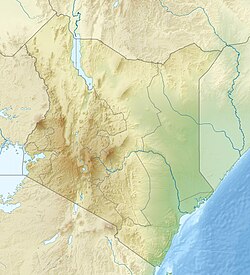You can help expand this article with text translated from the corresponding article in French. (December 2015) Click [show] for important translation instructions.
|
| UNESCO World Heritage Site | |
|---|---|
 | |
| Location | Mombasa, Kenya |
| Criteria | Cultural: ii, v |
| Reference | 1295 |
| Inscription | 2011 (35th Session) |
| Area | 2.36 ha |
| Buffer zone | 31 ha |
| Coordinates | 4°03′46″S 39°40′47″E / 4.06278°S 39.67972°E |

| History of Kenya |
|---|
 |
|
|
Fort Jesus (Portuguese: Forte Jesus de Mombaça, Spanish: Fuerte de Jesús) is a fort located on Mombasa Island. Designed by the Italian architect Giovanni Battista Cairati,[1] it was built between 1593 and 1596 by order of King Felipe II of Spain, who also reigned as King Filipe I of Portugal and the Algarves, to guard the Old Port of Mombasa. Fort Jesus is the only fort maintained by the Portuguese on the Swahili coast and is recognised as a testament to the first successful attempt by a Western power to establish influence over the Indian Ocean trade.[2]
Cairati, inspired by Italian architect Pietro Cataneo, designed the fort, with the master builder being Gaspar Rodrigues. This was Cairato's last overseas work. Although the design of Fort Jesus is an example of Renaissance architecture, the masonry techniques, building materials, and labor are believed to have been provided by the local Swahili people. The fort, built in the shape of a man viewed from the air, is roughly square with four bulwarks at its corners and is considered a masterpiece of late Renaissance military fortification.
Historical Significance
Fort Jesus was captured and recaptured at least nine times between 1631, when the Portuguese lost it to Sultan Yusuf ibn al-Hasan of Mombasa, and 1895, it fell under British rule and was converted into a prison. After the Portuguese recaptured it from the Sultan in 1632, they refurbished it and built more fortifications, subsequently making it harder for the fort to fall. The fort was subject to an epic two-year siege from 1696 to 1698 by the Omani Arabs, led by Saif bin Sultan. The capture of the fort marked the end of Portuguese presence on the coast, although they briefly captured and re-occupied it between 1728 and 1729 with the help of the Swahili city-states. The fort fell under local rule from 1741 to 1837, when it was again captured by the Omanis and used as a barracks, before its occupation by the British in 1895, after the establishment of the East Africa Protectorate (which later became, in 1920, the Colony and Protectorate of Kenya).
Preservation and Legacy
In 1958, Fort Jesus was declared a national museum. In 2011, it was declared a World Heritage Site by UNESCO and highlighted as one of the most outstanding and well-preserved examples of 16th-century Portuguese military fortifications.[2] The fort is Mombasa's most visited tourist attraction.
- ^ Parker, Geoffrey (18 April 1996). The Military Revolution: Military Innovation and the Rise of the West, 1500-1800. Cambridge University Press. ISBN 9780521479585. Retrieved 2 May 2017.
- ^ a b "Fort Jesus, Mombasa". UNESCO World Heritage Centre. Retrieved 1 January 2017.
